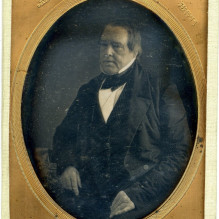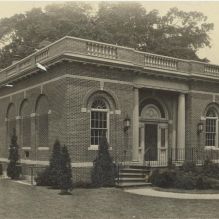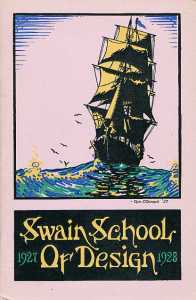Southcoast Artists Index
IN-FOCUS ARTICLE:
Swain School of Design
Cheeseburger in Paradise
The Swain School of Design Story
The ancient Egyptians knew and understood the power of memory. They saw beauty in what memory accomplished – completeness. Many of us wander about this world spending our lives looking for or trying to connect or reconnect with something or someone or even someplace. That is what this article is all about.
This is not The Swain School of Art Story. It is A Swain School of Art Story. Some of you may find the reference to a Broadway musical as corny but here goes anyway. It is the first of several song lyric references in this article to memory – from Cats: Memory.
All alone in the moonlight.
I can smile at the old days.
I was beautiful then. I remember.
The time I knew what happiness was.
Let the memory live again.
A Swain School of Design Story
What is it about the human soul? It soars to dizzying heights of fancy one moment and the next fills our pockets with stones. What is it about memories? They comfort and vex us. What is it about a place? You know, a place, like the one Dorothy Gale pined for in the classic book and movie – the Wizard of Oz?
What an apt last name by the way considering how a tornado turned her world upside down – or, did it really? Dorothy framed the lament and the universal sentiment that, “There’s no place like home.” At the end of the movie she says about her experience, “No, Aunt Em, this was a real, truly live place. And I remember that some of it wasn’t very nice – but most of it was beautiful.”
Good for Dorothy! Most of us tend to gloss over the unpleasant parts. However, we all go there. We’ve all been there and back time and time again. Why? It’s a safe and warm and comforting place. What is that place? Is there such a place in your life? We all have one or more places we still refer to or think of as ours.
Home is a place.
A private place. But some of our places are sometimes shared with others. There are public places we call our own even if we share them with others. When we share our memories with others who’ve had similar experiences it becomes our place. I wonder if the loss of a place we share with others is somehow greater than a loss of a place we experience alone.
When I think of a special, yet public place from my childhood, I think of the place across the street from the Capitol Theater on Acushnet Avenue in the north end of New Bedford that served cheeseburgers. They were so good that I still compare all cheeseburgers to those served there.
I can’t positively remember the name of the place but I do know that later in life I found the gustatory heir to that fabled place at the old Maxie’s Delicatessen in downtown New Bedford. It too offered all who ate there a sense of place.
It wasn’t home. It wasn’t work. It was a bit of heaven on earth. It was as the former owner of another restaurant in town described his place as, “A world away from the every day.”
Now that Maxie’s is gone, too, so to is the only link I had to paradise by way of a cheeseburger with fried onions on a grilled bun. For me, a sense of loss of both place and identity with what I considered perfection. Maxie’s was an institution. Our lives and memories are formed by many institutions. The corner store, school, church and, too many others to mention here. So now I arrive at the point of this article, the Swain School of Design.
The venerable and oft-lamented…
Swain began as the fulfillment of the will of New Bedford resident William W. Swain, a philanthropist. It offered the city’s residents courses free of charge. There were classes in language, literature, and history to name a few. Art was also on the curriculum as was a subject of most importance to a world leader in textiles – textile design.
By the turn of the century, the school’s name was changed to the one we’re most familiar with, along with the curricula to, the Swain School of Design. The name did not belie its new focus of offering students the fundamentals, principles, and application of design.
If you want to read more about the history of the Swain, as it is more commonly known, please visit this site or this one. This article is more a psychic reading, perhaps, than a historical sketch. What began as a series of ongoing conversations between two maturing, okay, older local artists: Don Wilkinson, friend and contributing writer and myself turned into the inspiration for this article. Swainees may be thinking as they read this, “Who the heck is he to write about our school?”
Ah, there’s the rub!
It’s amazing how the passion for this place still exists. Don, would then be the more likely author of this piece – yes! But, the older you get the more powerful the pull of nostalgia. Don is a great guy for lots of reasons and a fantastic writer, and he’s the logical guy to pen this article on the old Swain School.
He’s perfect! He received his BFA from Swain and his MFA from the University of Massachusetts Dartmouth. He has as Joni Mitchel sings in Both Sides…
I’ve looked at life from both sides now
From win and lose and still somehow
It’s life’s illusions I recall
I really don’t know life at all
But he’s not writing this one. I’m taking that chance. Please bear with me a bit longer. So what is it about this institution, the Swain School of Design, that evokes so much emotion to this very day? Perhaps it is because it is both here and not here. Sort of like the scent of my dad’s cologne that still remains on his hat. It continues reminding me of him in both a tangible and intangible way. He too is both here and not here.
Speak to alum like Don about Swain and you get more than yearning or nostalgia about the place. The physical aspect, the buildings on Hawthorn, Orchard, and County streets are there (and, not there) but now belong to and are used by someone else.
This feeling isn’t isolated. It’s universal. Although Dorothy believed there was no place like home, Thomas Wolfe reminded us that you can’t go home again. And that is the affliction I believe the Swainees collectively suffer from. Although the spirit of the institution lives on in the University of Massachusetts Dartmouth’s College of Fine and Applied Arts, it’s the sense of place that has been lost.
To some, it’s completely gone.
The heart was transplanted but the soul has been lost. From the perspective of someone who hung around the Swain in its still halcyon days in the early seventies, I can empathize. I can still hear the strains of the old Rasta Band belting out their seminal creation, I Love New Bedford (vintage eighties).
However, my empathy is more based on a shared sense of loss. In a way, we old SMTI (Southeastern Massachusetts Technological Institute)/SMU (Southeastern Massachusetts University) guys lost our place – the Group One building (now called the Liberal Arts Building) when the new and current College of Fine and Applied Arts building was erected. Our loss, in my opinion, is one of identity.
We can’t, try as we might, honestly and completely identify with UMass Dartmouth. I have actually seen old “Save SMU” bumper stickers here and there and it feels like a kick to my consciousness. Is it like having a step-parent, which as nice as they are, they’re just not your real mom or dad?
Change is both sought after by we simplistic humans as it is feared. The latter perhaps more so. The old Swain faculty (another story) also had to deal with many changes resulting from the merger, more so correctly, incorporation with the then SMU (Southeastern Massachusetts University) in 1988.
But, did the cultures merge? Again, another story that Don is more qualified to write. Although we (SMTI/SMU guys) had lots of Swain friends and hung out at the old place, we had our provincial opinion of them as art students. Of course, we believed our teachers and curriculum to be superior (in some or, many ways) to theirs as I’m sure they shared a similar opinion of us in our space-age concrete buildings.
Swain was/is (dependent on your point of view) a venerable institution whose presence and contributions to the area’s culture created a lasting impact. From those who dabbled and were sent or, sent their own children to the fabled Saturday morning art classes, to the undying emotional loyalty of its former day students, New Bedford’s Swain School of Design remains as real as the blood in their veins.
How? Why?
According to their Wikipedia site, “In the 1970s, there were only 100 students enrolled at any time, creating a close-knit environment for both students and faculty. Maybe the answer is in their 1980’s era catalog, ” The Swain School of Design is a purposefully intimate college where students can develop their creative, technical and artistic abilities, producing works which are thoughtful, vibrant contributions to our culture.”
Or, is it homogeneous versus heterogeneous? The chocolate combined with the peanut butter when the Swain School merged with Southeastern Massachusetts University’s College of Visual and Performing Arts after 107 years of autonomous operation but many refused to accept the new flavor. Some felt as if, to quote another Joni Mitchell song, Big Yellow Taxi, “they paved paradise and put up a parking lot.”
You can’t stop progress or the march of time. Memories can be preserved, passed on or, as Ken Dornstein, who wrote – The Boy Who Fell Out of the Sky – said, “…memory can become bound up with place; sites of loss can be sanctified, obliterated, or simply marked, like the cross by the side of the mountain road where the station wagon, kids asleep in the back, skidded off. ” Swainee or not SMTIee or SMUer, too), we should all be proud to feel the pain of the loss of something we felt to be perfect in our lives.
Recently the Hostess company was in the news.
They were shuttering their factories. The same factories that made the stuff of childhoods past and present; Twinkies, Ring Dings, Ho Hos and, I’ll bet someone reading this is cursing me for leaving out their favorite! I’ve come to the end of my rambling and will sign-off with yet another old song (for those old school readers) by Jimmy Buffet, whom I’ll use to compare the loss of the old Swain with the loss of not just the perfect cheeseburger, because that still exists in memory, but rather, the loss of access to that cheeseburger in paradise.
As the clock ticks and tocks we’re…
Makin’ the best of every virtue and vice
Worth every damn bit of sacrifice, yet another,
To get a cheeseburger in paradise
After all, we are our own cheeseburger – created in our image of perfection.
Please tell us your Swain, SMTI or SMU story here and share it with our readers.
PUBLISHER’S NOTE: This is an updated version of what was one of the first profile articles among many others. It was written in an initial attempt to document the lives and activities of the individuals, both past and present, who represent the cultural and creative community. These are the artists who drove/drive the local creative economy.
Our goal is to document the stories of the contemporary artists among us and those who have passed on either unnoticed or unremembered in a single location or repository.
There are many other stories out there like this one. It is our goal to seek out and find these other stories before they fade from memory.
Written by Ron Fortier in 2012 and posted on the predecessor website to the Artists Index, The South Coast Artist Profiles.



